We take a ‘deep dive’ into the original ZL1 & LT2 and recreated Long Lead Corvettes, Long Lead Press Previews, and reveal why proposed ZL1, LT2, LS6 and tri-power LJ2 super-high-performance big-block options for the ’70 Corvette never happened!
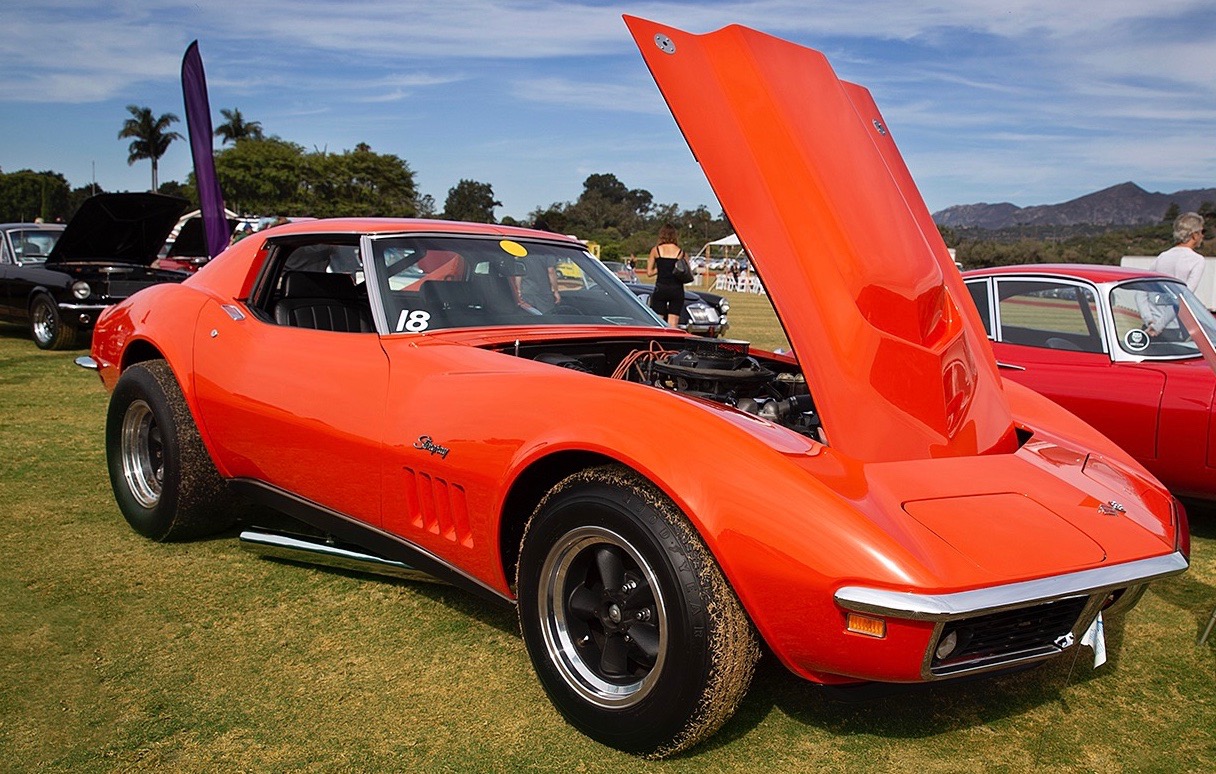
 Back in the day – the pre-historic, pre-Internet 1960s and 1970s – there were no bloggers, video influencers or e-zines. Enthusiasts relied on magazine editors and automotive journalists writing for print publications for the latest news from Motown. They attended summer “Long Lead Press Previews” to drive and photograph next-model-year vehicles for Fall issues. Hosted by domestic carmakers during June and July and typically held at their proving grounds, they gave media the three-month lead they needed to get stories out to coincide with new model introductions in September-October. Carmakers also hosted Short Lead drive events for newspaper and radio-TV media in September and October. The original one-of-none LT2 454: LIGHTWEIGHT CORVETTE broke cover summer of 1969, at the 1970 Long Lead Press Preview held at the GM Proving Ground, Milford, MI.
Back in the day – the pre-historic, pre-Internet 1960s and 1970s – there were no bloggers, video influencers or e-zines. Enthusiasts relied on magazine editors and automotive journalists writing for print publications for the latest news from Motown. They attended summer “Long Lead Press Previews” to drive and photograph next-model-year vehicles for Fall issues. Hosted by domestic carmakers during June and July and typically held at their proving grounds, they gave media the three-month lead they needed to get stories out to coincide with new model introductions in September-October. Carmakers also hosted Short Lead drive events for newspaper and radio-TV media in September and October. The original one-of-none LT2 454: LIGHTWEIGHT CORVETTE broke cover summer of 1969, at the 1970 Long Lead Press Preview held at the GM Proving Ground, Milford, MI.
It was not unusual for manufacturers to specially tune or even build “ringers”, hot-rodded, stock-appearing models to keep high-performance enthusiast media like myself, when I was Editor of Hi-Performance CARS, entertained. Proving grounds offered media controlled, safe environments for wringing out cars, especially high-performance variants. It gave manufacturers a lot of leeway creating some truly potent vehicles, like the LT2 Long Lead Corvette – powered by a four-inch stroked ZL1 all-aluminum big-block displacing 454 cubic inches.
 Chevrolet Engineering created the original, stock-ish looking Corvette, known as the Long Lead Corvette (LLC) or Saturday Night Special (SNS). I first saw it in early-July 1969 at its encore appearance at GM’s Milford Proving Ground. Unfortunately I missed its first appearance in July 1968. That car is long gone, most likely parted-out and/or crushed. The (Original) LLC is Dead; Long Live the (Tribute) LLC!
Chevrolet Engineering created the original, stock-ish looking Corvette, known as the Long Lead Corvette (LLC) or Saturday Night Special (SNS). I first saw it in early-July 1969 at its encore appearance at GM’s Milford Proving Ground. Unfortunately I missed its first appearance in July 1968. That car is long gone, most likely parted-out and/or crushed. The (Original) LLC is Dead; Long Live the (Tribute) LLC!
Vintage Gasser enthusiast and collector Dave Miller owns the picture-perfect recreation of the original Long Lead Corvette. Like the original, the Tribute is also based on a donor vehicle originally delivered to Chevrolet Public Relations in 1968 during the same time frame. It actually could have been the one chosen for the first build!
Very little information about the fabled LT2 454: LIGHTWEIGHT CORVETTE was published back in the day. The first article was written by Eric Dahlquist – 10-SECOND TRIP – in the October 1969 Motor Trend. It also received minimal coverage in at least one other Petersen Publishing magazine. Decades later, Paul Stenquist penned an excellent feature – A Blast While It Lasted, Unique Corvette Earns An Encore – showcasing the Tribute LLC in the August 17, 2014 edition of The New York Times.
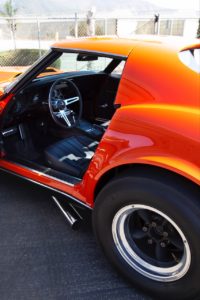 Noted historian-author and ex-GM executive who worked closely with Zora Arkus-Duntov and GM Design – Karl Ludvigsen – did write about the LLC a few years after its 1969 media exposure. There were no details of its ill-fated 454-inch LT2 aluminum engine, however. Quotes below are from Ludvigsen’s CORVETTE, America’s Star-Spangled Sports Car, The Complete History on Page 228-229 of the first edition in 1973; Page 560 in the latest (2014) edition. It’s requisite reading for every Corvette enthusiast: https://www.amazon.com/Corvette-Americas-Star-Spangled-Sports-1953-1982/dp/083761659X
Noted historian-author and ex-GM executive who worked closely with Zora Arkus-Duntov and GM Design – Karl Ludvigsen – did write about the LLC a few years after its 1969 media exposure. There were no details of its ill-fated 454-inch LT2 aluminum engine, however. Quotes below are from Ludvigsen’s CORVETTE, America’s Star-Spangled Sports Car, The Complete History on Page 228-229 of the first edition in 1973; Page 560 in the latest (2014) edition. It’s requisite reading for every Corvette enthusiast: https://www.amazon.com/Corvette-Americas-Star-Spangled-Sports-1953-1982/dp/083761659X
“A car prepared by Chevy engineers Gib Hufstader and Tom Langdon for drag racing, geared at 4.88 to one and driving through a special Turbo Hydra-Matic, reached 127 mph in the quarter after only 11.00 seconds from rest.”
“Abusing the gearbox by slamming it from Neutral into Drive at 6,000 rpm,” said GM test engineer Bob Clift. “It took off like a striped-ass ape, yielding a time of 10.9 seconds and trap speed of 130 mph. Attributes of the special Turbo Hydro were reworked valving, a high-rpm governor, and a small diameter 11-inch Chevy II torque converter giving a higher 4,000 rpm stall speed. Other attributes included blueprinting of the V-8, steel tubular headers and M&H 10.65 x XS-12 Racemaster slicks running at 6-psi pressure.”
“With a start from Neutral into Drive yielded a time of 10.89 seconds and speed of 130 mph. This was performance at a level almost unprecedented among quasi-production cars offered for sale to the public.”
“Tom Langdon built the engine,” said Hufstader. “He got about 710 horsepower out of it. I built the car.”
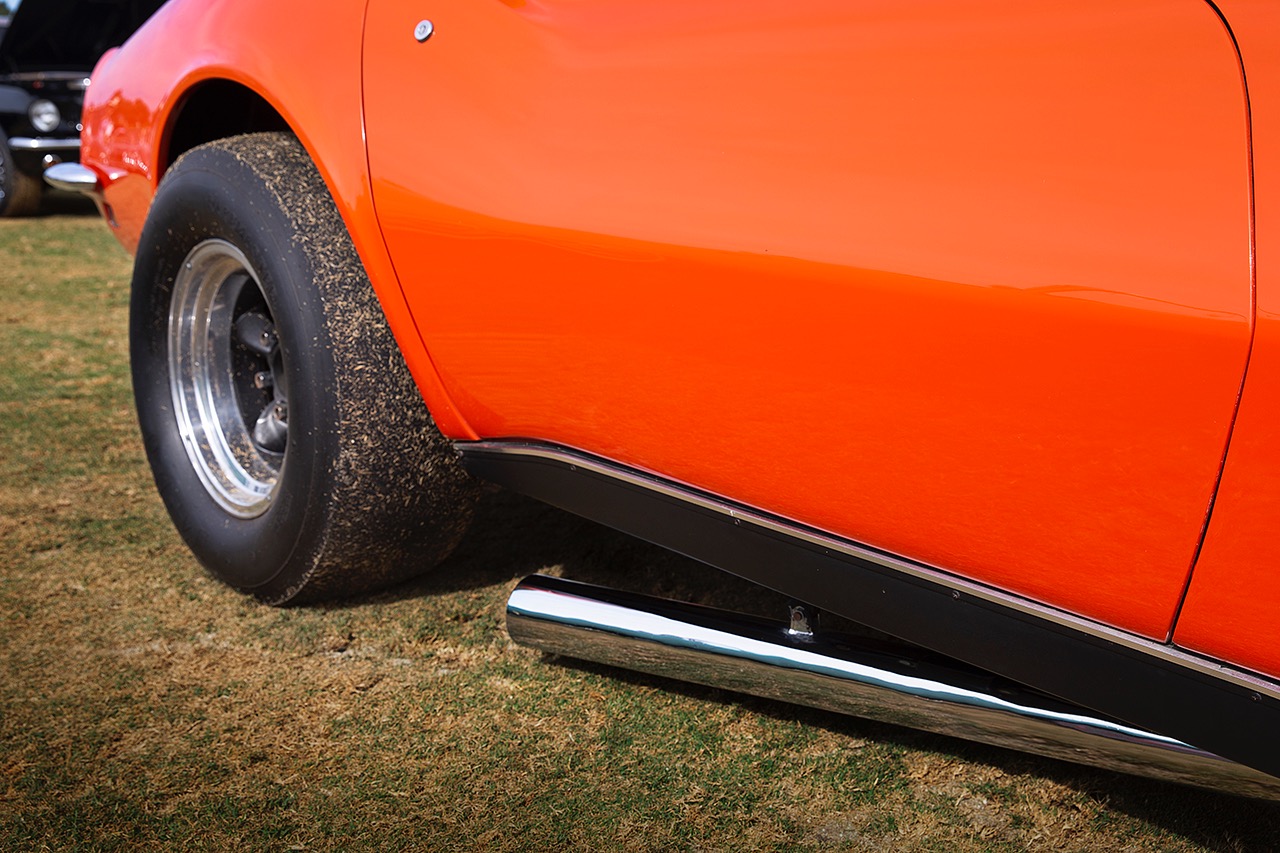 In reality, this Corvette was a one-off and technically bore almost no resemblance to even the much-ballyhooed 427 ZL1 Corvette. In a memo to Engineering, Walter Mackenzie, Chevrolet Public Relations Director, requested the build of a “special performance” Corvette, with PR supplying the donor vehicle. It first appeared in the summer of 1968 at the 1969 Long Lead Press Preview, powered by an all-aluminum 427 ZL1. When it returned in 1969 for the 1970 Long Lead, it had been put on a serious diet and its 427 replaced with a 454-inch aluminum LT2 engine that, other than internally, never existed. The lightened Corvette had few if any creature comforts. It was built to impress journalists and distract from the lack of 1970 Camaros and Corvettes that would have normally been at the event. The LT2 454: LIGHTWEIGHT CORVETTE succeeded on both counts!
In reality, this Corvette was a one-off and technically bore almost no resemblance to even the much-ballyhooed 427 ZL1 Corvette. In a memo to Engineering, Walter Mackenzie, Chevrolet Public Relations Director, requested the build of a “special performance” Corvette, with PR supplying the donor vehicle. It first appeared in the summer of 1968 at the 1969 Long Lead Press Preview, powered by an all-aluminum 427 ZL1. When it returned in 1969 for the 1970 Long Lead, it had been put on a serious diet and its 427 replaced with a 454-inch aluminum LT2 engine that, other than internally, never existed. The lightened Corvette had few if any creature comforts. It was built to impress journalists and distract from the lack of 1970 Camaros and Corvettes that would have normally been at the event. The LT2 454: LIGHTWEIGHT CORVETTE succeeded on both counts!
Nothing was ever written about Chevrolet needing cars like the aluminum engined 454 “boy racer” at the 1970 Long Lead. Traditionally there would have been all-new ’70 Gen II Camaros and updated ’70 Corvettes for journalists to drive. Didn’t happen! Hampered with quality/production problems, they would be late to market and Chevrolet ended up hosting a separate press introduction later in the year at Riverside Raceway in California for 1970 ½ models.
 The LLC Corvette joined other “performance-enhanced” cars, including Zora Duntov’s racing-striped white 427 ZL1 Stingray convertible with fender flares, Goodyear race tires, outside header exhausts and a trick hood secured with racecar pins, at the 1970 Long Lead. Zora’s Corvette Mule, prepared by Gib Hufstader, weighed 2,900 pounds, ran the quarter in 12.10s at over 115 mph and sprinted to 60 mph in the low 4s. It was available only for white-knuckle rides with Zora!
The LLC Corvette joined other “performance-enhanced” cars, including Zora Duntov’s racing-striped white 427 ZL1 Stingray convertible with fender flares, Goodyear race tires, outside header exhausts and a trick hood secured with racecar pins, at the 1970 Long Lead. Zora’s Corvette Mule, prepared by Gib Hufstader, weighed 2,900 pounds, ran the quarter in 12.10s at over 115 mph and sprinted to 60 mph in the low 4s. It was available only for white-knuckle rides with Zora!
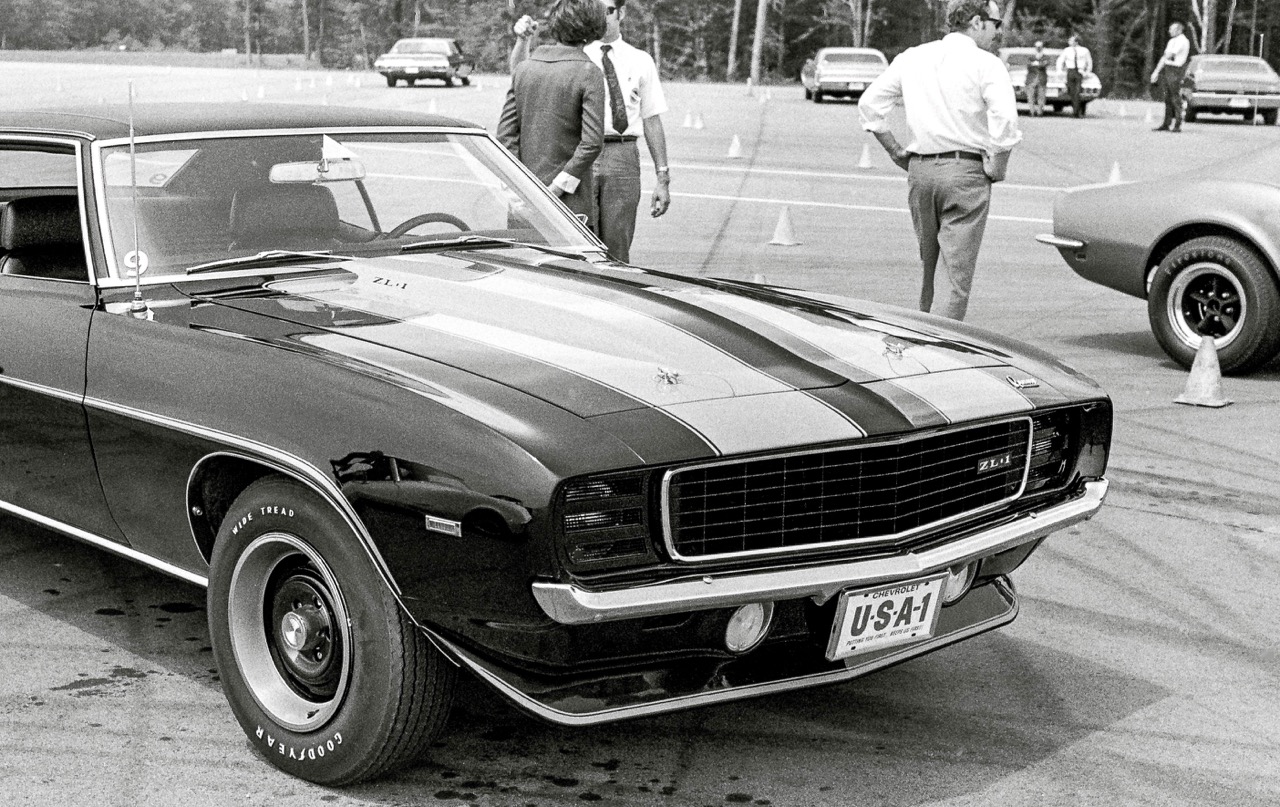 There was also a trick SS350 Nova, powered by the upcoming Corvette solid-lifter 350/370 small-block rated at 360 horsepower. It was the prototype for the ’70 Yenko Nova Duece. Topping off “entertainment” for the media was a gold-trimmed Tuxedo Black ’69 Camaro (COPO 9567), powered by a tamed version of the 427-inch all-aluminum ZL1 race engine. There had been a proposed 100-car build of automatic and manual transmission ZL1 road Camaros that never got past the Pilot-build stage. Chevrolet made sure that there were unique performance cars to make up for the lack of new Camaros and Corvettes.
There was also a trick SS350 Nova, powered by the upcoming Corvette solid-lifter 350/370 small-block rated at 360 horsepower. It was the prototype for the ’70 Yenko Nova Duece. Topping off “entertainment” for the media was a gold-trimmed Tuxedo Black ’69 Camaro (COPO 9567), powered by a tamed version of the 427-inch all-aluminum ZL1 race engine. There had been a proposed 100-car build of automatic and manual transmission ZL1 road Camaros that never got past the Pilot-build stage. Chevrolet made sure that there were unique performance cars to make up for the lack of new Camaros and Corvettes.
The event’s most potent, most interesting of all the vehicles breathed on by Chevrolet Engineering was a Monaco Orange ’69 Stingray, that had started life as a base ’68 Corvette coupe. Showcasing custom 180-degree headers and outside 36-inch megaphone-collector exhausts, it announced its arrival with the raucous, piercing sound of an open exhaust road racer. Rumors swirled around at the time about it being “plated” and seen making some runs on Motown’s street racing hub, Woodward Avenue. Hence, the LT2 454: LIGHTWEIGHT CORVETTE Saturday Night Special (SNS) moniker.
Once behind its steering wheel it was impossible not to notice the block-off plate on the auto shifter assembly, preventing manual Low-Drive shifting and potential over-revving of the aluminum big-block. The console-mounted engine ID plaque, below, broadcast: 454 cubic inches LT2. As installed, the LT2 had produced 584 horsepower on Chevrolet Engineering’s dyno. However, at least one engineer on the project claimed that he had seen readings over 700 horsepower!
 Like most of us attending the Long Lead, I was aware that the new Corvette would have a 454 replacing the 427. I also knew about the solid-lifter LT1 small-block, but nothing about an LT2 or any aluminum big-block engine. Years later I discovered that the plan was to offer five super-performance Corvette big-block options, including the all-alloy LT2 454, for 1970. Like the COPO 9567 ZL1 Camaro, those Corvette options were not meant to be. After 1969, ZL1 aluminum engines were no longer installed in cars, available only through GM Service Parts.
Like most of us attending the Long Lead, I was aware that the new Corvette would have a 454 replacing the 427. I also knew about the solid-lifter LT1 small-block, but nothing about an LT2 or any aluminum big-block engine. Years later I discovered that the plan was to offer five super-performance Corvette big-block options, including the all-alloy LT2 454, for 1970. Like the COPO 9567 ZL1 Camaro, those Corvette options were not meant to be. After 1969, ZL1 aluminum engines were no longer installed in cars, available only through GM Service Parts.
Some cars are easily replicated because originals are still around and/or there are lots of period magazines with photos and descriptions. Plus, copious online coverage. In the case of the Long Lead Corvette, the original ’68 Corvette, updated to ’69 Stingray trim, disappeared decades ago and few magazines had actually featured it. Fortunately Motor Trend did; original photography from that story was available from the publication’s archives. But the key to the Tribute’s build details was availability of the Chevrolet Engineers who built and tuned the original, as well as other savvy ex-GM techs. And, as owner Dave Miller discovered, they couldn’t wait to replicate the 10-second Corvette that rocked the clocks at the Milford Proving Ground in 1969!
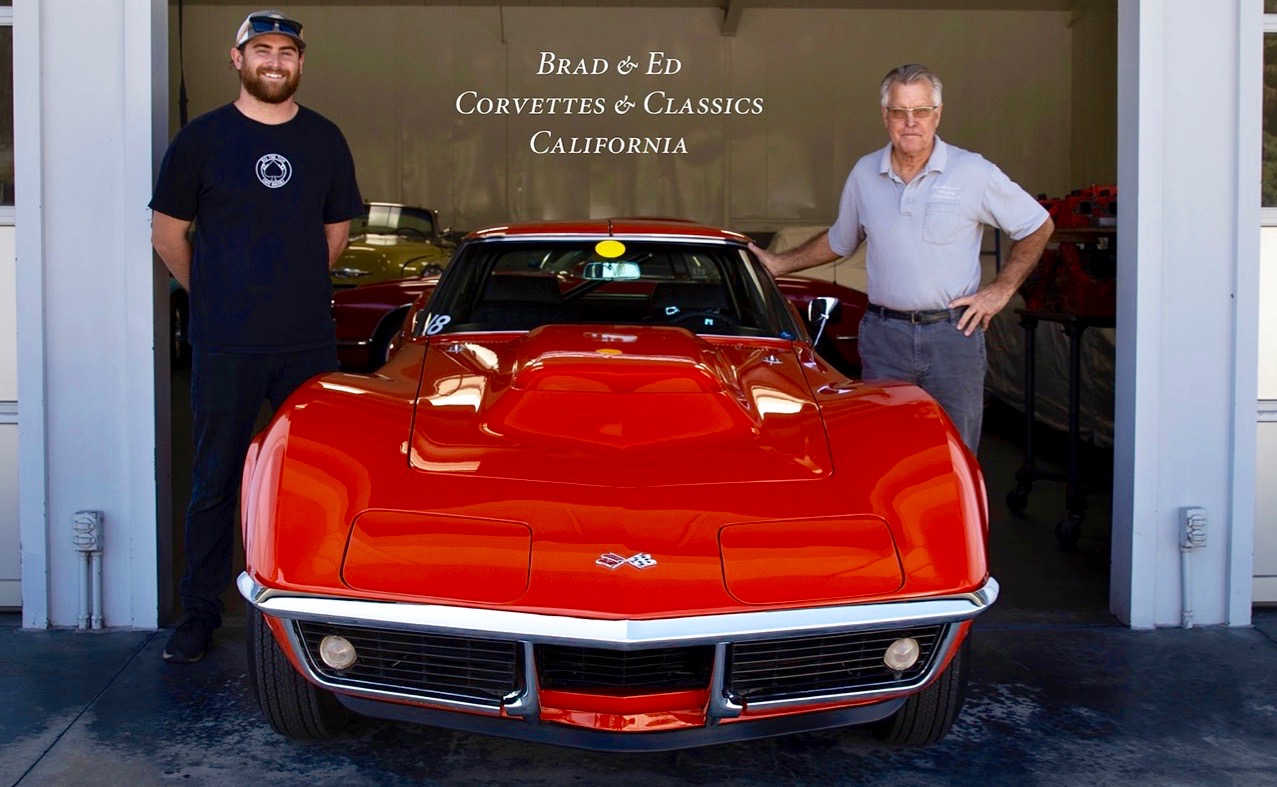 “It actually all started with an engine, a ZL1 engine,” said Dave. “I think it was around 2005 when Corvette Service Center’s Ed Wittwer, above, right, with Brad Lonson, who had been a friend since the early-1980s, offered me a real-deal ZL1, date-coded early-1969, as I had a Corvette drag car in my collection of vintage Gassers. Ed became involved and was instrumental in the building of my LLC/LT2.”
“It actually all started with an engine, a ZL1 engine,” said Dave. “I think it was around 2005 when Corvette Service Center’s Ed Wittwer, above, right, with Brad Lonson, who had been a friend since the early-1980s, offered me a real-deal ZL1, date-coded early-1969, as I had a Corvette drag car in my collection of vintage Gassers. Ed became involved and was instrumental in the building of my LLC/LT2.”
The ZL1 engine’s DRE-stamped open-chamber alloy heads had obviously been worked on. Dave photographed the heads and had his friend Jon Mello, who had owned the first ‘67 Z/28 Camaro Trans-Am racecar, research the head stampings and codes. That led him to Jim Cavallero, who had owned DRE (Diamond Racing Engines) back in the day and still had original engine building records. Paperwork indicated that the engine was built in the 1970s for Kevin Lambert for his ’69 Corvette L88 coupe. He was working for Chevrolet at the time. It had never been fully assembled and run and that’s exactly how it ended up in 2005 at the Corvette Service Center in Carpenteria, CA, a highly respected source for hard-to-find parts and classic Corvette services,http://corvetteservicecompany.com/corvetteservice/index.html
Dave Miller tracked down Kevin who had left Chevrolet in the 1980s to work for Ford, retired, and was working for Jack Roush. Dave wanted to install the ZL1 in a Willys gasser or possibly a Super/Stock Camaro. Kevin was pushing for a ZL1 Corvette build. On one of Dave’s trips to Detroit to visit with Kevin, they had dinner with some of Kevin’s Chevrolet alumni (who Dave had never met): Gibson ‘Gib’ Hufstader, Tom Langdon and Bill Howell, who worked for Vince Piggins, the man behind the Z/28 Camaro, ZL1 Camaro and just about every high-performance project in the 1960s-1970s.
“Gib brought along a stack of internal Chevrolet documents from 1968 and 1969 and said, ‘Dave, that engine should go into this Corvette’, referencing the Corvette that he and Tom had built for Chevy PR in 1968 and rebuilt in 1969 for Long Lead Press Previews.”
 Dave Miller didn’t need much coaxing. He got the band back together again, assembling an incredibly talented and enthusiastic group for one more gig: To pay tribute to the LT2 454: LIGHTWEIGHT CORVETTE that only a few people outside of GM even knew existed. That included revisiting the backstory behind the original.
Dave Miller didn’t need much coaxing. He got the band back together again, assembling an incredibly talented and enthusiastic group for one more gig: To pay tribute to the LT2 454: LIGHTWEIGHT CORVETTE that only a few people outside of GM even knew existed. That included revisiting the backstory behind the original.
The key players: Gib Hufstader, retired GM engineer who had worked with Zora Arkus-Duntov and whose Corvette credits also included the Grand Sport, AeroVette, twin-turbo LT5, and a host of others. He was inducted into the Corvette Hall of Fame in 2001. Tom Langdon, a GM retiree and Corvette restoration specialist who also had worked on the original LLC Corvette. At the time, Tom Langdon was a successful drag racer with a couple of class wins at the NHRA Nationals to his credit.
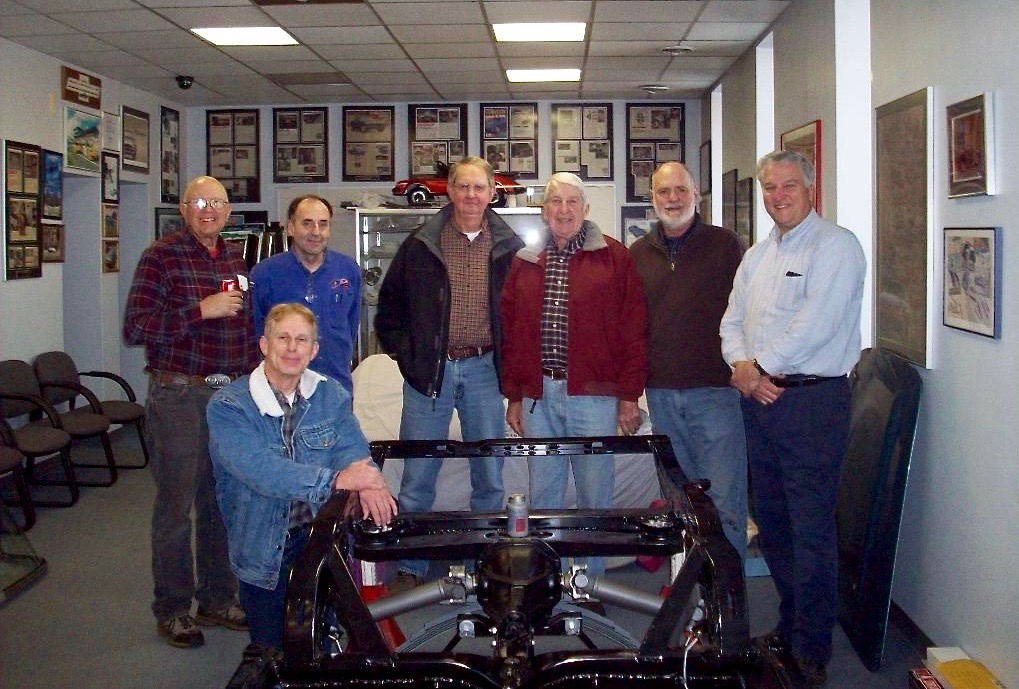 Team LLC at Masterworks, left to right: Tom Langdon, Denny Hummel, Dwight Bliss, Gib Hufstader, Dave Miller, Werner Meier and Kevin Lambert, kneeling.
Team LLC at Masterworks, left to right: Tom Langdon, Denny Hummel, Dwight Bliss, Gib Hufstader, Dave Miller, Werner Meier and Kevin Lambert, kneeling.
Werner Meier, retired GM engineer, collector and owner of Masterworks Automotive joined the team. Meier had spent much of his GM career involved with Corvette Concept cars, Styling cars, and cars specifically built for GM Design legends, Harley Earl and Bill Mitchell. He was inducted into the Corvette Hall of Fame in 2013. Meier had spent many years as Group Manager, Chevrolet Engineering at the Milford Proving Ground. His Masterworks Automotive facility in Sterling Heights, MI, https://mwauto.com/index.php provided a home for this unique Tribute build. Engine builder, Denny Hummel, Kevin Lambert and Dwight Bliss, a GM retiree assigned to source parts for the project, joined them. Kevin let Dave know that he would be able to supply a NOS prototype LT2 console plaque.
The donor car for the original Long Lead Corvette project was a ’68 coupe with a base 327/300 small-block, M40 Turbo HydraMatic and a Posi rear. Ordered by Chevrolet Public Relations, it was a plain-jane small-block car without AC. When first converted into a “boy racer” by Chevrolet Engineering for the 1969 model year Long Lead, it was fitted with a 427-inch aluminum ZL1 big-block. Its engine block was painted traditional Chevrolet red so as not to reveal its true lightweight DNA.
When this car (GM ID #98044) resurfaced one year later at the 1970 Long Lead, it had become a kick-ass, tire-smoking Supercar capable of running in the high-10s. A mysterious blueprinted 454-inch all-aluminum LT2 engine with open-chamber heads, dynoed at 584 horsepower and 542 pound-feet torque at 6,400 rpm, rested under its hood.
Proposed as the top power option for the new ’70 Corvette, the all-aluminum LT2, along with the 454/460 LS7 (steel block, open-chamber aluminum heads), didn’t make the cut thanks to an initiative to limit high cost, low-volume high horsepower choices, simplify production and save money. John Z. DeLorean was at Chevrolet’s helm, and led the charge to “de-pro” (de-proliferate) engine options for Corvettes.
According to retired-GM engineer and author Kenneth W. Kayser in his book, Corvette Legend Or Myth & Zora’s Marque of Excellence, Volume II Zora’s Fabulous Mid-Ship Corvette History, “DeLorean assigned Alex Mair to de-proliferate the Corvette’s engine lineup for 1970. Don McPherson’s assignment from Mair was justified by John ‘Z’ as, ‘profit improvement’. The ‘70 Corvette’s fabulous 427 (RPO) ZL1 @430 HP and three 454 (RPO) engines were targeted: LJ2 Tri-Power @ 440 HP( #3952357), LS6 @450 HP (L88 w/iron heads); LT2 @465 HP (#3963517 L88/ZL1).”
Kayser added, “ All four 1970 Corvette Mark IV high-performance engines bit the dust despite the fact they were fully developed, ready for build at Tonawanda Engine Plant and offered a significant variable profit. Tonawanda continued to build LS6 & LS7 engines and components for GM Service Parts at barely break-even cost at least through 1999.”
“With days to go before the St. Louis Corvette plant built the last ’69 Corvette on December 30th, DeLorean eliminated the ’70 Corvette’s: ZL1, LJ2, LS6 and the ultimate LT2 engines under the ‘ruse’ of increasing profit. Before St. Louis resumed ’70 Corvette production in January, 1970, John ‘Z’ also terminated the fifth Corvette LS7 Mark IV engine.”
“At least one, (possibly two – four-speed and automatic), Pilot-build ’70 Corvette was powered by the incredible LT2 and it showed up with six other primered Pilots at Bill Mitchell’s Styling Dome meeting for GM General Managers. Five of the seven were fitted with Turbo HydraMatics; two were four-speed sticks. They were powered by LS6, LS7, LT2, ZL1 and LJ2 engines; the tri-power LJ2 was the mildest, most streetable.”
“Rinke Chevrolet, a local area dealership founded in 1917 that handled most special factory Corvette sales, probably sold some or possibly all of those Pilots. One was purchased (as a used, year-old car) by a secretary at CEC (Chevrolet Engineering Center), sight unseen as a retirement present to herself in 1971. It proved to be too hairy a ride for her and not long after taking delivery, she sold it back to Rinke Chevrolet,” added Kayser who worked at Tonawanda during this period, was involved in L88 and ZL1 production, and from 1990 to 1994 was the Mark V (454/502) Engine Business Unit Manager.
Corvette Legend Or Myth & Zora’s Marque of Excellence, Volume II Zora’s Fabulous Mid-Ship Corvette History has 750 pages filled with almost 1,500 historic photos, documents and blueprints, including engineers Fred Fricke and Tom Langdon’s December 1969 engine option charts showing LS6, LS7 and LT2 applications, is available from Tachometer Publishing, http://www.tachometerpublishing.com/order/vol-2
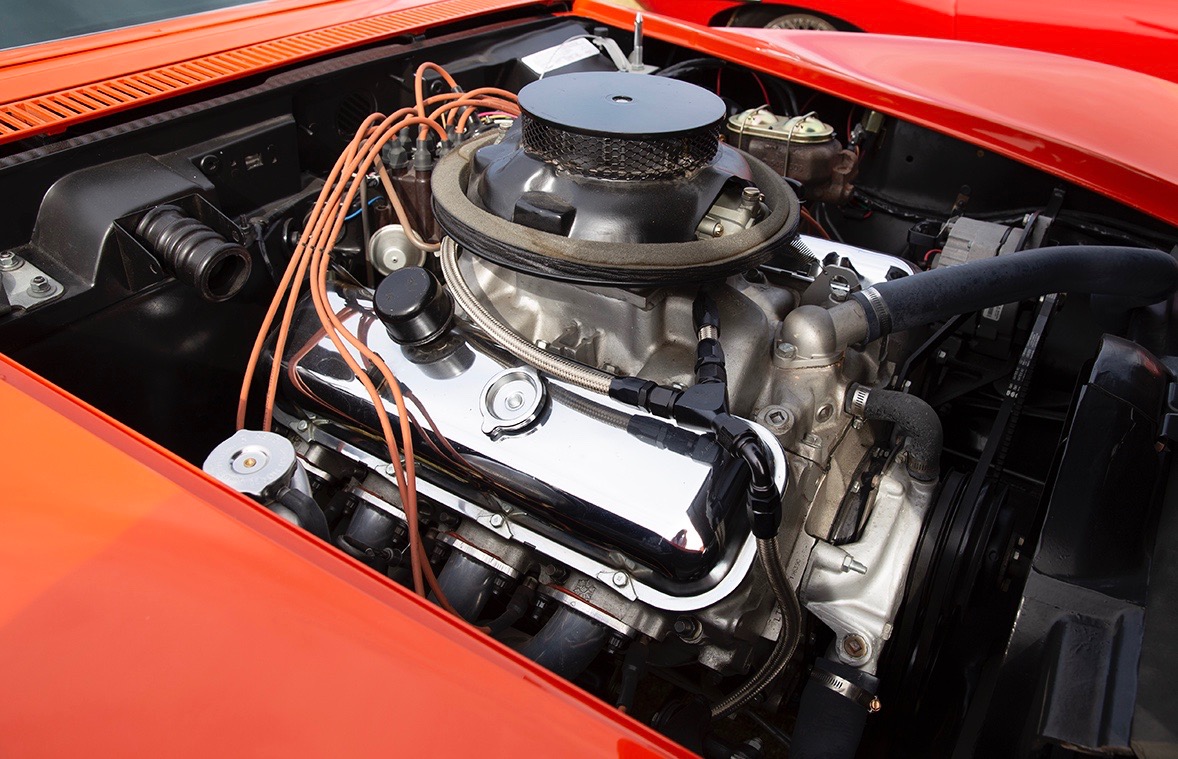 The recreated LT2 alloy 454, utilizing a ZL1 block with four-bolt mains, 4-inch-stroke Tuftrided (hardened) 454 crank, forged TRW pistons, forged rods, 180-degree headers and a camshaft with profile specs from noted drag racer Wally Booth and ground by Crower Cams, was built by Chess Racing’s Denny Hummel. Tom Langdon, who had tuned the LLC’s original LT2 engine, designed the intake manifold modifications for its Holley 4500 Dominator four-barrel. While the original LT2 engine was tuned to run on 120-plus octane Avgas, the new LT2 454: LIGHTWEIGHT CORVETTE gets by with 112-octane race gas.
The recreated LT2 alloy 454, utilizing a ZL1 block with four-bolt mains, 4-inch-stroke Tuftrided (hardened) 454 crank, forged TRW pistons, forged rods, 180-degree headers and a camshaft with profile specs from noted drag racer Wally Booth and ground by Crower Cams, was built by Chess Racing’s Denny Hummel. Tom Langdon, who had tuned the LLC’s original LT2 engine, designed the intake manifold modifications for its Holley 4500 Dominator four-barrel. While the original LT2 engine was tuned to run on 120-plus octane Avgas, the new LT2 454: LIGHTWEIGHT CORVETTE gets by with 112-octane race gas.
Retired GM engineer Tom Langdon worked on the original LT2 engine and intake and exhaust systems, and oversaw the building and detailing of the new engine. The block’s VIN pad is stamped, “LT2 1963-9-C,” whereas the original engine’s internal ID number was M-4 “427” 1963-8-B.
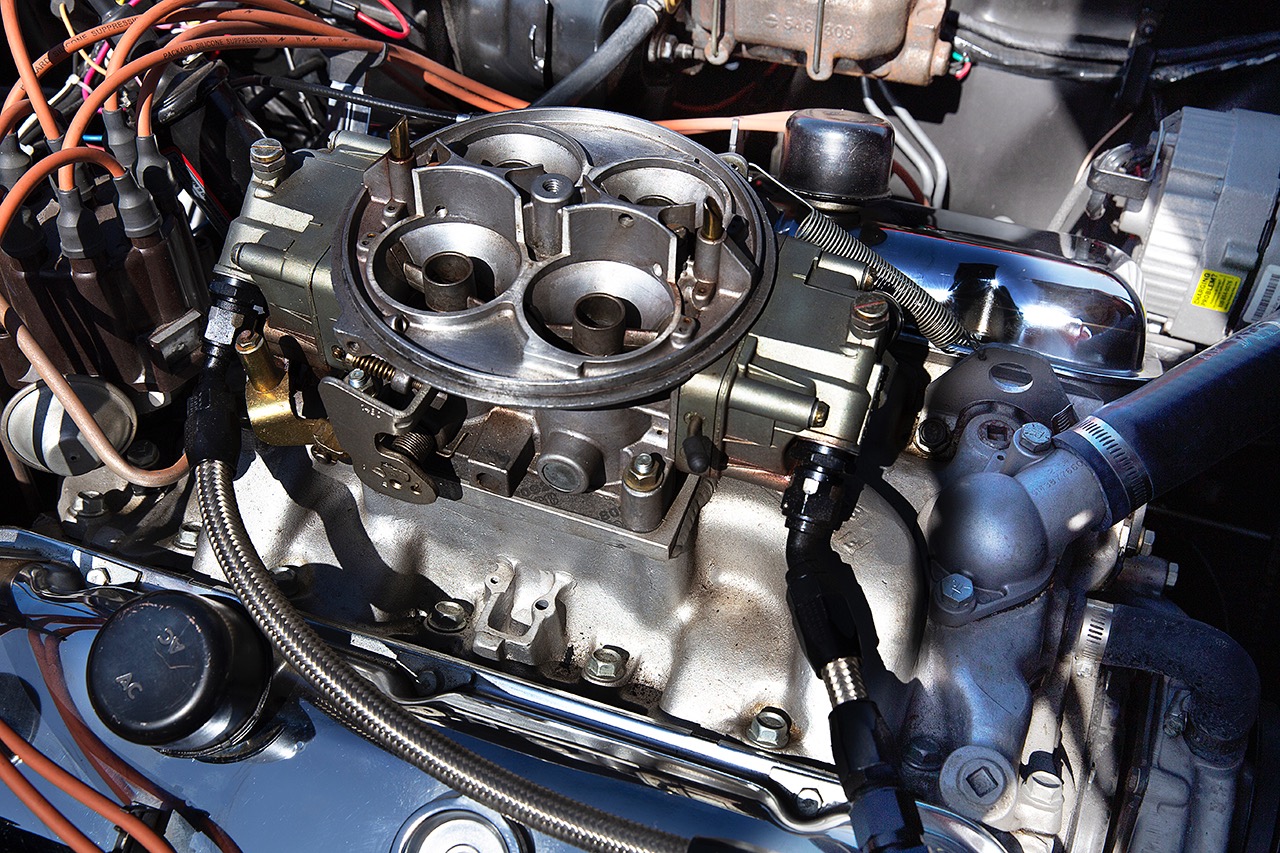 Introduced in the late-1960s primarily for NASCAR and later for drag racing, Holley 4500 Dominators flowed from 1,050 to approximately 1,400 cfm. On the LT2, its Dominator was rated at 1,050 -1,100 cfm. Chevrolet Engineering originally modified the ginormous four-barrel, and it was Tom Langdon who milled down the Dominator’s air horns. The new LT2 is also fitted with an early Dominator, modified with partially milled air horns by So-Cal mechanical injection and carburetion specialist, Augie Delgado at Exotic Induction.
Introduced in the late-1960s primarily for NASCAR and later for drag racing, Holley 4500 Dominators flowed from 1,050 to approximately 1,400 cfm. On the LT2, its Dominator was rated at 1,050 -1,100 cfm. Chevrolet Engineering originally modified the ginormous four-barrel, and it was Tom Langdon who milled down the Dominator’s air horns. The new LT2 is also fitted with an early Dominator, modified with partially milled air horns by So-Cal mechanical injection and carburetion specialist, Augie Delgado at Exotic Induction.
Originally OK Kustom Headers, a supplier of specialty exhaust systems to Chevrolet and Corvette and Camaro racers, handcrafted the complex 180-degree firing order headers and side outlet pipes designed by Tom Langdon. Langdon supplied the specifications and the team donated photos from the original Motor Trend photo shoot to Tom Stiel, ex-McLaren tech, who created the new system, including tapered 36-inch long megaphone collectors. You would be hard-pressed to find another Corvette, other than the new C8-R racecar, that sounds as aggressive as Miller’s LT2 454: LIGHTWEIGHT CORVETTE!
 Working with a correct date-coded ZL1 block and heads, the team tried to get as much “originality” as possible when building the Tribute’s engine. Diamond Racing Engines, Detroit, MI was an engine building and machine shop that Chevrolet used for “backdoor” racing projects and assistance during engine development programs. Diamond blueprinted the original LLC’s ZL1 heads and its co-founder Jim Cavallaro recreated those head modifications for Dave Miller.When the new LT2 engine was buttoned up it was turned over to Impastato Racing Engines in Chesterfield, MI for break-in and max power dyno runs. Whereas the original LT2 produced 584 horsepower at 6,400 rpm, the Tribute LT2 delivers 624 horsepower at the same rpm.
Working with a correct date-coded ZL1 block and heads, the team tried to get as much “originality” as possible when building the Tribute’s engine. Diamond Racing Engines, Detroit, MI was an engine building and machine shop that Chevrolet used for “backdoor” racing projects and assistance during engine development programs. Diamond blueprinted the original LLC’s ZL1 heads and its co-founder Jim Cavallaro recreated those head modifications for Dave Miller.When the new LT2 engine was buttoned up it was turned over to Impastato Racing Engines in Chesterfield, MI for break-in and max power dyno runs. Whereas the original LT2 produced 584 horsepower at 6,400 rpm, the Tribute LT2 delivers 624 horsepower at the same rpm.
The old hot rodding adage – “There’s no substitute for cubic inches except more cubic inches” – only goes so far. It would not have been wise to further increase the LT2’s engine displacement at the time, because that would not only have been costly, but also would have negatively impacted the engine’s reliability. So, the team followed Colin Chapman’s mantra of “adding lightness” for more performance. And, that’s exactly what Team Miller did creating the LT2 454: LIGHTWEIGHT CORVETTE.
 From 20 feet away you probably would not have noticed that the original LLC had a chromed fiberglass front bumper, Plexiglas side windows, thin glass windshield, radio/heater delete, non-operable headlamp assemblies, deleted windshield wipers and motor, a lack of sound deadening materials, and even a lightweight steering column bracket. The lightweight domed hood relied on stagger-mounted hood pins replacing the Corvette’s traditional hood latching hardware. Weight was approximately 2,800 pounds. Dave Miller’s recreated LLC has a chromed steel bumper, stock windshield, functional electric Lexan side windows, gutted headlight assemblies, roll bar, and a rear gear change from 4.88 to 4.56 Posi. Like the original, the steering column bracket was lightened and all sound deadener was removed. Plans are in place to fabricate a chromed fiberglass front bumper. It currently weighs in at approximately 3,000 lbs.
From 20 feet away you probably would not have noticed that the original LLC had a chromed fiberglass front bumper, Plexiglas side windows, thin glass windshield, radio/heater delete, non-operable headlamp assemblies, deleted windshield wipers and motor, a lack of sound deadening materials, and even a lightweight steering column bracket. The lightweight domed hood relied on stagger-mounted hood pins replacing the Corvette’s traditional hood latching hardware. Weight was approximately 2,800 pounds. Dave Miller’s recreated LLC has a chromed steel bumper, stock windshield, functional electric Lexan side windows, gutted headlight assemblies, roll bar, and a rear gear change from 4.88 to 4.56 Posi. Like the original, the steering column bracket was lightened and all sound deadener was removed. Plans are in place to fabricate a chromed fiberglass front bumper. It currently weighs in at approximately 3,000 lbs.
I noticed when researching vintage coverage of the original Long Lead Corvette and its performance at the Milford Proving Ground, little or nothing had been mentioned about its reliability. Here was a Corvette powered by a blueprinted, stroked 454-inch ZL1 alloy motor, hooked up to a modified M40 automatic transmission and 4.88 Posi gears, and hooking up on M&H Racemaster wrinkle-wall slicks. And, it was driven by a number of automotive journalists (some experienced; most not!) through the clocks at Milford. Miracle of miracles, it survived!
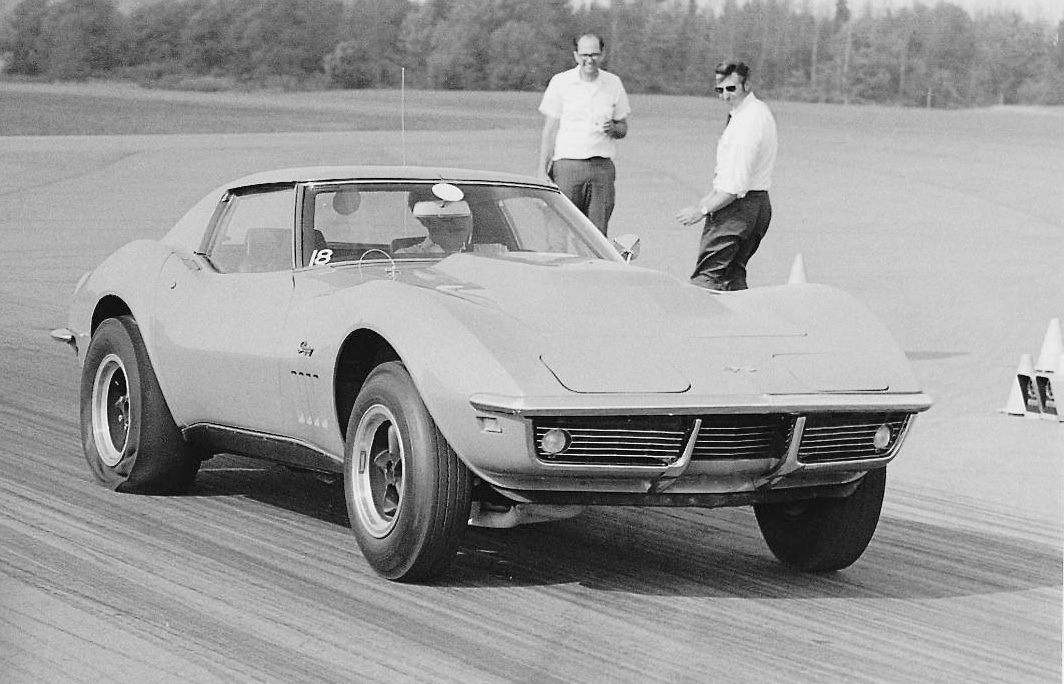 Gib Hufstader kept detailed notes of each and every full throttle run in the blistering summer sun over two days in 1969, a total of 71 without a single failure. The top time, 10.89 seconds and speed of 130 mph was recorded on Day One; followed by 15 runs on the morning of Day Two. When Motor Trend returned to Milford for private testing, Eric Dahlquist, above, MT photo, clocked a new best time: low-10.60s at 130-132 mph.
Gib Hufstader kept detailed notes of each and every full throttle run in the blistering summer sun over two days in 1969, a total of 71 without a single failure. The top time, 10.89 seconds and speed of 130 mph was recorded on Day One; followed by 15 runs on the morning of Day Two. When Motor Trend returned to Milford for private testing, Eric Dahlquist, above, MT photo, clocked a new best time: low-10.60s at 130-132 mph.
Journalists weren’t the only guys to beat in this hot-rodded Corvette. Project’s engineers, including Gib, Tom Langdon and Bob Clift, Corvette development engineer/test driver, also made passes through the clocks. Clift had been involved with Gib on the Grand Sport program, responsible for the legendary RPO 687 racing option for C1 Corvettes, and was an active SCCA competitor. The LLC’ reliability was as impressive as its performance. Its F41 optional Corvette suspension, modified by chassis engineer Dan Crawford, allowed the LLC to hook up with minimal fuss. He added 90/10 front drag shocks for weight transfer on launch and installed 3-inch rubber snubbers and 2-inch spacers on the rear suspension and a 2-inch metal block on top of the hub carrier to ward off axle hop.
It’s truly hard not to be impressed when seeing Dave Miller’s one-of-none Long Lead Corvette. Original production 1968 C3 Corvettes were far from quality builds. Fit and finish left an awful lot to be desired. The recreated LLC has benefited from a concours-quality build/restoration at Masterworks Automotive. It was debuted at the NCRS Michigan & Heart of Ohio meeting in November 2013 and one year later displayed at MCACN (Muscle Car And Corvette Nationals) in Chicago, below, where I saw it for the first time since the summer of 1969 at the GM Proving Ground. It was like seeing an old friend after 45 years!
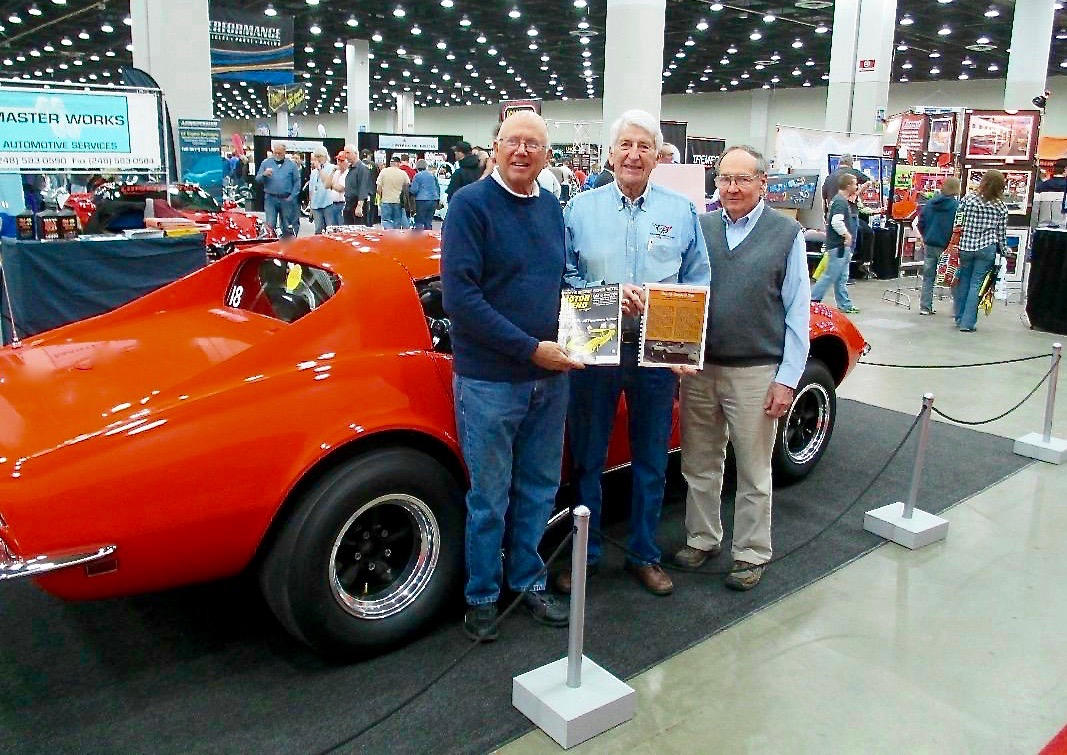 2014 MCACN, left to right: Tom Langdon, Gib Hufstader and Dan Crawford holding a copy of the October 1969 issue of Motor Trend with Eric Dahlquist’s original LLC story, 10 Second Trip.
2014 MCACN, left to right: Tom Langdon, Gib Hufstader and Dan Crawford holding a copy of the October 1969 issue of Motor Trend with Eric Dahlquist’s original LLC story, 10 Second Trip.
Now that Dave Miller has relocated from California to Florida, the LLC will be spending a lot of time in the care of George Haddad at Fabulous Restorations in Ft. Lauderdale,http://fabulousrestorations.com/
“We’ll be going through the LT2 454: LIGHTWEIGHT CORVETTE since little has been done mechanically since it was built. When we finish, Dave has asked me to take it to PBIR (Palm Beach International Raceway) to see if we can beat the best time (10.86 @ 124.64 mph) it turned running a 4.56 gear at Milan Dragway in May 2015,” said Haddad.
Since there was one (possibly two) Pilot-build ’70 Corvette fitted with the all-aluminum 454 LT2 engine, there’s always the possibility that one might still be out there stashed away in a barn. You never know!
NOTE: Props to the GM engineers who in 1969, created the 10-second, aluminum 454-powered LT2 Stingray that brought smiles to the faces of auto magazine journalists lined up to drive 1970 models at Chevy’s Long Lead Press Preview. Thanks to Dave Miller, some of those very same GM engineers also created its Monaco Orange Doppelganger.
SPECIAL THANKS to CGC contributor Jim Palam,http://www.jimpalam.com/ for shooting the photos of the LT2 454: LIGHTWEIGHT CORVETTE while at Ed Wittwer’s Corvette Service Center and the 8th Annual Montecito Motor Classic Show that he had covered for us. And, for suggesting that we do this feature.
